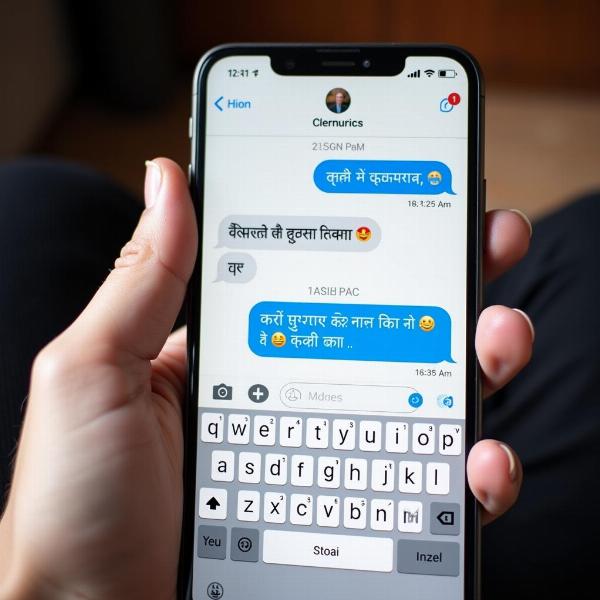Understanding the various ways to express “sent” in Hindi is crucial for accurate communication. Whether you’re translating documents, having a casual conversation, or delving into Hindi literature, knowing the nuances of this seemingly simple word can significantly impact your understanding. This article explores the different Hindi translations of “sent,” considering the context and providing practical examples to help you master its usage. “Sent in Hindi meaning” can encompass a range of words and phrases, depending on what was sent, who sent it, and how it was sent.
Decoding “Sent” in Hindi: A Multifaceted Approach
The Hindi equivalent of “sent” depends heavily on the context. Are you talking about sending a letter? A message? A person? Each scenario requires a different Hindi word or phrase. Let’s delve into some common scenarios and their corresponding translations.
Sending Physical Objects
When referring to sending a physical object like a letter, parcel, or gift, the Hindi verb “bhejna” (भेजना) is typically used. For example:
- “I sent a letter.” translates to “Maine ek patra bheja” (मैंने एक पत्र भेजा).
- “She sent a gift.” translates to “Usne ek tohfa bheja” (उसने एक तोहफ़ा भेजा).
Sending Messages
For sending messages, emails, or texts, the verb “bhejna” (भेजना) is still applicable, but other options exist depending on the nuance you want to convey. “Patra bhejna” might be suitable when there is a certain formality attached with the communication.
- “I sent a message.” can be translated as “Maine ek sandesh bheja” (मैंने एक संदेश भेजा).
- “He sent an email.” can be “Usne ek email bheja” (उसने एक ईमेल भेजा).
 Sending a Text Message in Hindi
Sending a Text Message in Hindi
Sending Someone (Dispatching)
If you’re talking about sending someone somewhere, meaning dispatching or instructing someone to go, you might use verbs like “bhejna” (भेजना) but the most accurate translation could be based on the specific context. For instance, consider the difference between:
- “I sent him to the market.” translated as “Maine use bazaar bheja.” (मैंने उसे बाज़ार भेजा). The implication being that you instructed or directed the person to go to the market.
- “The company sent a representative.” translated as “Kampani ne ek pratinidhi bheja.” (कंपनी ने एक प्रतिनिधि भेजा). In this case, the company dispatched or delegated the task to a specific person.
Deeper Dive into “Bhejna” and its Variations
While “bhejna” (भेजना) is a versatile verb, understanding its various forms and conjugations is essential. The past tense, as seen in the examples above, changes depending on the gender and number of the subject. Similarly, the future tense and other forms will also vary. Learning these variations is crucial for grammatical accuracy.
“Sent in Hindi meaning” – Considering Nuances
Sometimes, “sent” can imply a feeling or emotion. For example, “God sent him to us” carries a different connotation than simply sending someone. In such cases, the Hindi translation might involve words like “ishwar ne use humein diya” (ईश्वर ने उसे हमें दिया) instead of “bhejna” (भेजना), changing it to a more religious sentiment. Thus, understanding the underlying message is crucial for choosing the appropriate Hindi equivalent.
Conclusion: Mastering the Art of “Sending” in Hindi
As we have explored, translating “sent” in Hindi requires a nuanced understanding of the context. From sending physical objects to conveying abstract emotions, the correct choice of words can greatly influence the meaning of your message. By familiarizing yourself with the various Hindi translations and their appropriate usage, you can effectively communicate and avoid misunderstandings. Remember, “sent in Hindi meaning” isn’t just about finding a single word; it’s about capturing the essence of the action within the cultural and linguistic landscape of Hindi.
FAQ:
- What is the most common Hindi word for “sent”? The most common word is “bhejna” (भेजना).
- Can “bhejna” be used for both physical objects and messages? Yes, “bhejna” is versatile and can be used for both.
- Are there other words besides “bhejna” that can be used for “sent”? Yes, other words and phrases can be used depending on the context, such as variations of “bhejna” or words reflecting a religious sentiment.
- How do I conjugate “bhejna”? The conjugation depends on the tense, gender, and number of the subject. Consult a Hindi grammar resource for detailed conjugation rules.
- How do I choose the right Hindi word for “sent”? Consider the context of the sentence and what is being sent to determine the most accurate translation.
absent in hindi meaning
consent in hindi meaning
present in hindi meaning
meaning of dissent in hindi
Meaning-Hindi.in is your trusted partner for accurate and culturally sensitive Hindi translation services. We specialize in various translation domains, including business, legal, technical, website localization, educational, and specialized content. Our expert linguists ensure your message resonates effectively with your target audience. Contact us today for all your Hindi translation needs at [email protected] or call us at +91 11-4502-7584. Meaning-Hindi.in is here to bridge the language gap for you.